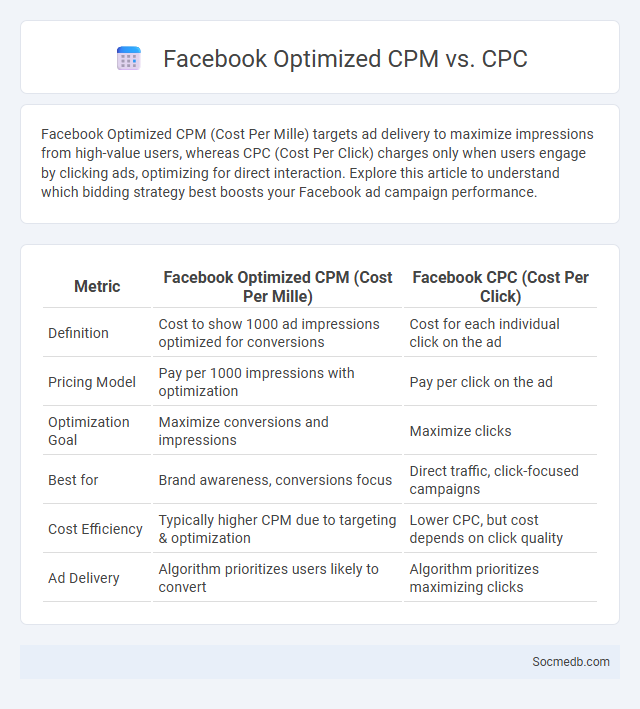
Photo illustration: Facebook Optimized CPM vs CPC
Facebook Optimized CPM (Cost Per Mille) targets ad delivery to maximize impressions from high-value users, whereas CPC (Cost Per Click) charges only when users engage by clicking ads, optimizing for direct interaction. Explore this article to understand which bidding strategy best boosts your Facebook ad campaign performance.
Table of Comparison
| Metric | Facebook Optimized CPM (Cost Per Mille) | Facebook CPC (Cost Per Click) |
|---|---|---|
| Definition | Cost to show 1000 ad impressions optimized for conversions | Cost for each individual click on the ad |
| Pricing Model | Pay per 1000 impressions with optimization | Pay per click on the ad |
| Optimization Goal | Maximize conversions and impressions | Maximize clicks |
| Best for | Brand awareness, conversions focus | Direct traffic, click-focused campaigns |
| Cost Efficiency | Typically higher CPM due to targeting & optimization | Lower CPC, but cost depends on click quality |
| Ad Delivery | Algorithm prioritizes users likely to convert | Algorithm prioritizes maximizing clicks |
Introduction to Facebook Advertising Models
Facebook advertising models offer various options to help you reach specific audiences effectively. These models include Cost Per Click (CPC), Cost Per Mille (CPM), and Cost Per Action (CPA), each designed to optimize your campaign based on desired outcomes such as clicks, impressions, or completed actions. Understanding these models allows your business to allocate budget efficiently and boost engagement through targeted ads.
What is Optimized CPM (oCPM) on Facebook?
Optimized CPM (oCPM) on Facebook refers to a bidding strategy that automatically optimizes ad delivery to maximize desired outcomes, such as conversions or clicks, while controlling costs per thousand impressions. This approach leverages Facebook's machine learning algorithms to target users most likely to engage, improving campaign efficiency compared to standard CPM bidding. Advertisers utilizing oCPM benefit from enhanced return on ad spend (ROAS) by focusing budget on high-value audiences rather than broad traffic.
Understanding Cost Per Click (CPC) in Facebook Ads
Understanding Cost Per Click (CPC) in Facebook Ads is crucial for optimizing advertising budgets and maximizing return on investment. CPC represents the amount advertisers pay each time a user clicks on their ad, reflecting the competition and relevance of the ad within the Facebook ad auction system. Tracking and analyzing CPC helps marketers refine targeting strategies and improve ad creatives to achieve lower costs and higher engagement rates.
Conversion-Based Bidding Explained
Conversion-based bidding is a strategy used in social media advertising that optimizes ad delivery to users most likely to complete a desired action, such as a purchase or sign-up. Platforms like Facebook and Instagram leverage machine learning algorithms to analyze user behavior and historical conversion data, enhancing the precision of ad targeting and budget allocation. This method increases return on ad spend (ROAS) by focusing on high-intent audiences rather than just impressions or clicks.
Key Differences Between oCPM, CPC, and Conversion Bidding
oCPM (optimized Cost Per Mille) focuses on delivering ads to users most likely to convert, optimizing for conversions rather than just impressions. CPC (Cost Per Click) charges you only when someone clicks your ad, prioritizing traffic generation over conversion quality. Conversion bidding specifically targets users based on their likelihood to complete a desired action, making it ideal for maximizing return on ad spend.
Targeting and Optimization Strategies
Effective social media targeting leverages user demographics, interests, and behaviors to tailor content and ads precisely to Your ideal audience, increasing engagement and conversion rates. Optimization strategies include continuous A/B testing, analysis of performance metrics, and refining targeting parameters to maximize ROI. Utilizing advanced algorithms and AI-driven insights ensures campaigns are dynamically adjusted for enhanced reach and relevance.
Performance Metrics and KPIs Comparison
Social media performance metrics such as engagement rate, click-through rate (CTR), conversion rate, and follower growth offer critical insights into the effectiveness of content strategies across platforms like Facebook, Instagram, and Twitter. Key Performance Indicators (KPIs) should be tailored to campaign objectives, including reach, impressions, and share of voice to measure brand visibility and audience interaction. Comparing these KPIs helps marketers identify high-performing channels, optimize ad spend, and refine content for improved ROI and customer acquisition.
Budget Allocation for oCPM, CPC, and Conversion
Effective budget allocation for social media campaigns involves prioritizing oCPM (optimized cost per mille) to maximize ad delivery efficiency, CPC (cost per click) to control direct engagement costs, and conversion tracking to measure ROI accurately. Allocating a larger portion of your budget to oCPM enhances automated optimization for ad impressions, while CPC allocation helps refine targeting based on click rates. Monitoring conversion data ensures your spend aligns with actual sales or lead generation, allowing you to adjust your strategy dynamically for optimal performance.
Choosing the Right Bidding Strategy for Your Campaign
Choosing the right bidding strategy for your social media campaign depends on your specific goals such as brand awareness, lead generation, or conversions. Platforms like Facebook and Instagram offer options like cost-per-click (CPC), cost-per-impression (CPM), and cost-per-acquisition (CPA) to optimize your budget effectively. Analyzing audience behavior and campaign objectives ensures the selected bidding strategy maximizes return on ad spend (ROAS) and overall engagement.
Conclusion: Maximizing ROI with Facebook’s Bidding Options
Facebook's bidding options offer businesses precise control over ad spend, enabling targeted audience reach and enhanced conversion rates. By leveraging features like cost cap, bid cap, and target cost, marketers can optimize campaign budgets for maximum return on investment. Effective bid strategy implementation ensures improved ad performance, reduced costs per acquisition, and sustained growth in customer engagement.
 socmedb.com
socmedb.com